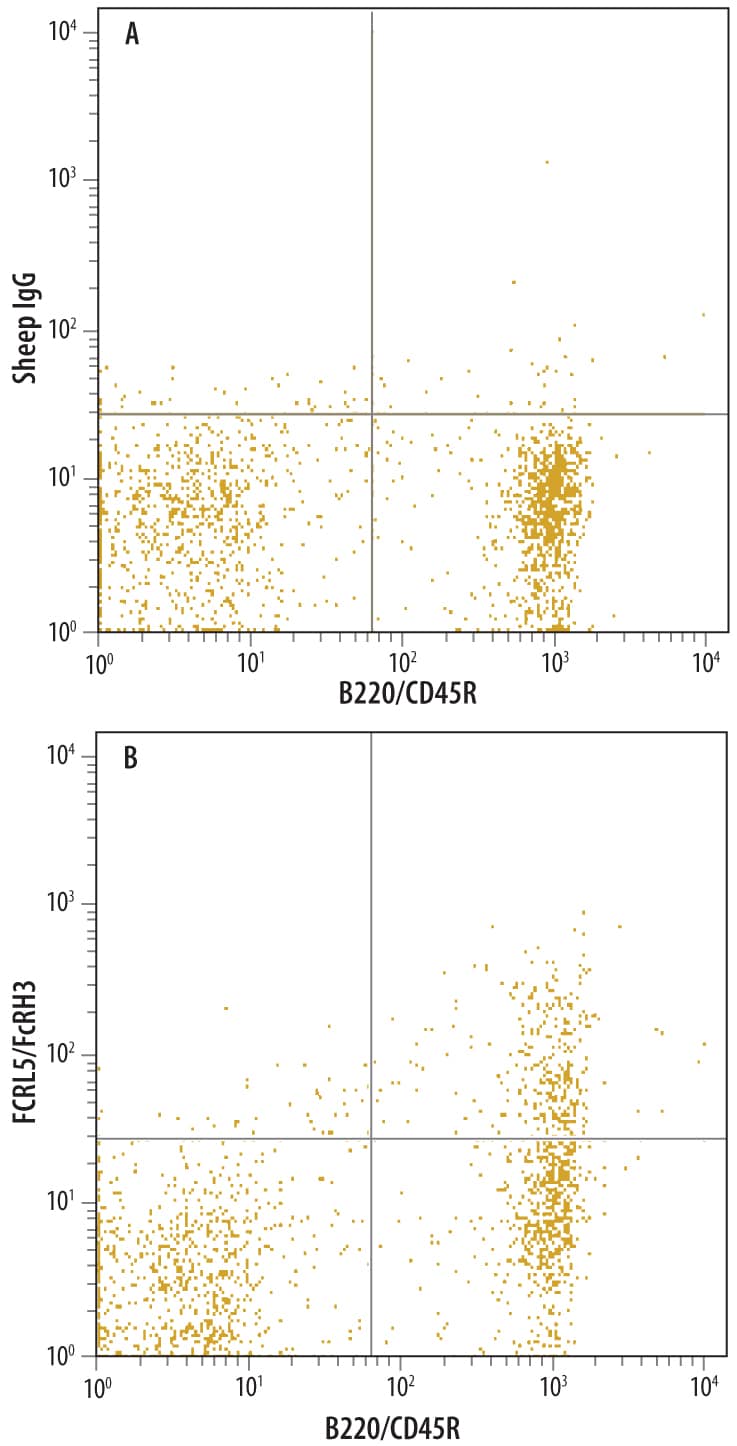Mouse FCRL5/FcRH5 Antibody
R&D Systems, part of Bio-Techne | Catalog # AF6757


Key Product Details
Species Reactivity
Mouse
Applications
CyTOF-ready, Flow Cytometry
Label
Unconjugated
Antibody Source
Polyclonal Sheep IgG
Product Specifications
Immunogen
Mouse myeloma cell line NS0-derived recombinant mouse FCRL5/FcRH3
Gln27-Ala496 (predicted)
Accession # NP_899045
Gln27-Ala496 (predicted)
Accession # NP_899045
Specificity
Detects mouse FCRL5/FcRH3 in direct ELISAs. In direct ELISAs, less than 1% cross-reactivity with recombinant human FCRL5 is observed.
Clonality
Polyclonal
Host
Sheep
Isotype
IgG
Scientific Data Images for Mouse FCRL5/FcRH5 Antibody
Detection of FCRL5/FcRH3 in Mouse Splenocytes by Flow Cytometry.
Mouse splenocytes were stained with Sheep Anti-Mouse FCRL5 Antigen Affinity-purified Polyclonal Antibody (Catalog # AF6757) followed by Allophycocyanin-conjugated Anti-Sheep IgG Secondary Antibody (Catalog # F0127) and Rat Anti-Mouse B220/CD45R PE-conjugated Monoclonal Antibody (Catalog # FAB1217P). Quadrant markers were set based on control antibody staining (Catalog # 5-001-A).Applications for Mouse FCRL5/FcRH5 Antibody
Application
Recommended Usage
CyTOF-ready
Ready to be labeled using established conjugation methods. No BSA or other carrier proteins that could interfere with conjugation.
Flow Cytometry
2.5 µg/106 cells
Sample: Mouse splenocytes
Sample: Mouse splenocytes
Formulation, Preparation, and Storage
Purification
Antigen Affinity-purified
Reconstitution
Sterile PBS to a final concentration of 0.2 mg/mL. For liquid material, refer to CoA for concentration.
Formulation
Lyophilized from a 0.2 μm filtered solution in PBS with Trehalose. *Small pack size (SP) is supplied either lyophilized or as a 0.2 µm filtered solution in PBS.
Shipping
Lyophilized product is shipped at ambient temperature. Liquid small pack size (-SP) is shipped with polar packs. Upon receipt, store immediately at the temperature recommended below.
Stability & Storage
Use a manual defrost freezer and avoid repeated freeze-thaw cycles.
- 12 months from date of receipt, -20 to -70 °C as supplied.
- 1 month, 2 to 8 °C under sterile conditions after reconstitution.
- 6 months, -20 to -70 °C under sterile conditions after reconstitution.
Background: FCRL5
References
- Davis, R.S. (2007) Annu. Rev. Immunol. 25:525.
- Maltais, L.J. et al. (2006) Nat. Immunol. 7:431.
- Won, W-J. et al. (2006) J. Immunol. 177:6815.
- Davis, R.S. et al. (2004) Int. Immunol. 16:1343.
- Hatzivassiliou, G. et al. (2001) Immunity 14:277.
- Miller, I. et al. (2002) Blood 99:2662.
- Polson, A.G. et al. (2006) Int. Immunol. 18:1363.
- Vidal-Laliena, M. et al. (2005) Cell. Immunol. 236:6.
- Haga, C.L. et al. (2007) Proc. Natl. Acad. Sci. 104:9770.
- Mohan, J. et al. (2006) Blood 107:4433.
- Campbell, J.A. et al. (2010) J. Immunol. 185:28.
- Ise, T. et al. (2005) Clin. Cancer Res. 11:87.
- Ise, T. et al. (2007) Leukemia 21:169.
- Kazemi, T. et al. (2009) Cancer Immunol. Immunother. 58:989.
- Ise, T. et al. (2006) Clin. Chem. Lab. Med. 44:594.
Long Name
Fc Receptor-like 5
Alternate Names
BXMAS1, CD307e, FcRH5, IFGP5, IRTA2, PRO820
Gene Symbol
FCRL5
UniProt
Additional FCRL5 Products
Product Documents for Mouse FCRL5/FcRH5 Antibody
Product Specific Notices for Mouse FCRL5/FcRH5 Antibody
For research use only
